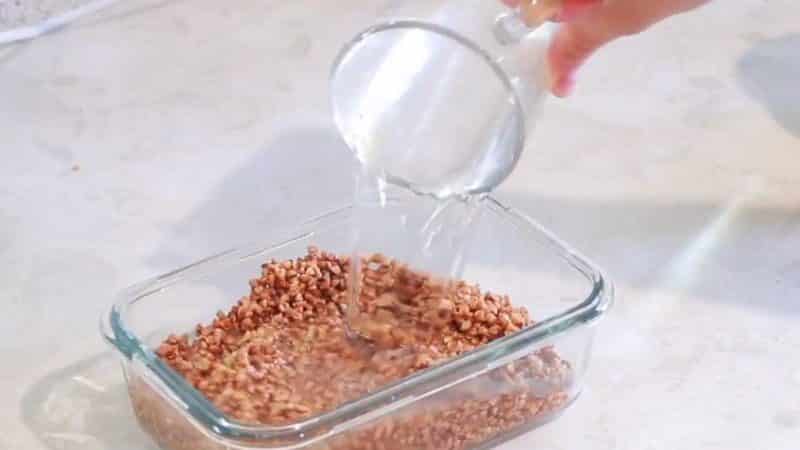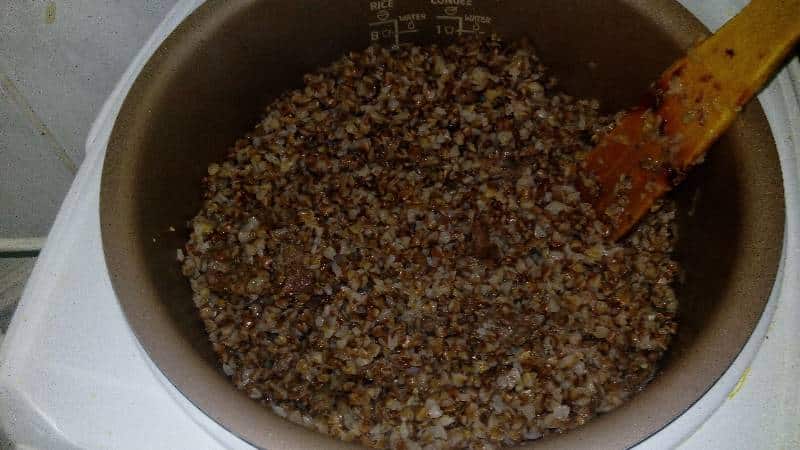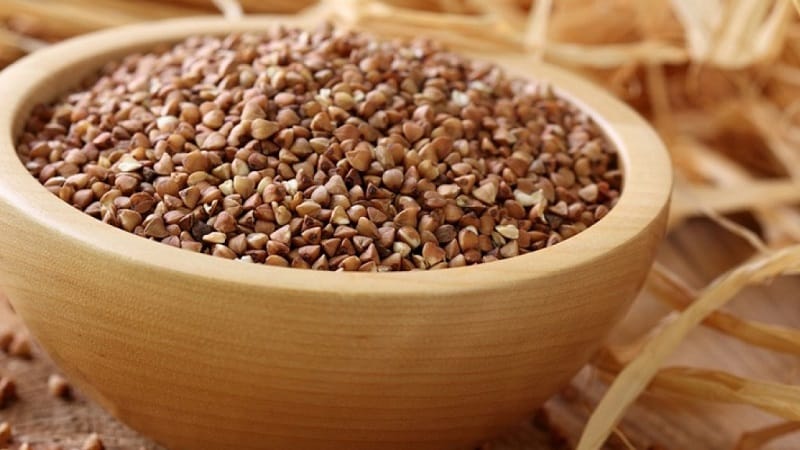Beneficial properties and calorie content of buckwheat steamed with boiling water
Cereals are a rich source of energy and substances valuable to the body. Cereals cleanse the intestines, improve digestion and metabolism. Regular consumption of grain crops reduces the risk of heart and vascular diseases by 20%, promotes weight loss, prevents skin diseases, and gives youth and beauty.
Almost every cereal is characterized beneficial properties, But buckwheat is especially popular in our country. Its nutritional qualities directly depend on the variety and quality of the grain and the method of cooking.
What are the advantages of steamed buckwheat over boiled buckwheat?
Depending on the cooking method, the calorie content and nutritional value of buckwheat change. During the cooking process, cereals lose most of their valuable compounds, so steaming is considered the most suitable method of culinary processing.
It is better to steam buckwheat overnight in a thermos or saucepan with a tight-fitting lid.

How to cook buckwheat:
- Sort out the grains to remove foreign impurities and rinse until clear water.
- Pour into a thermos or airtight container and pour boiling water over it - 1 tbsp. buckwheat for 2 tbsp. water.
- Close the lid tightly and wrap in a warm towel. Leave until morning, but not less than 4 hours.
Natural soy sauce, vegetable oil, low-fat kefir and yogurt are used as a dressing.
Chemical composition, vitamins and microelements of steamed buckwheat
Steamed buckwheat retains almost all the substances that nature generously endowed it with.
100 g of steamed cereal without salt and oil contains:
- water - 75 g;
- proteins - 3.0 g;
- fats - 3.4 g;
- carbohydrates - 14.6 g: starch and dextrins - 13.3 g, sugars - 1.3 g;
- dietary fiber - 2.7 g;
- ash - 1.4 g;
- thiamine (B1) - 0.08 mg;
- riboflavin (B2) - 0.04 mg;
- niacin (B3) - 0.9 mg;
- choline (B4) - 20.1 mg;
- pantothenic acid (B5) - 0.4 mg;
- pyridoxine (B6) - 0.1 mg;
- folacin (B9) - 14.0 mcg;
- ascorbic acid (vitamin C) - 11 mg;
- vitamin K - 1.9 mcg;
- vitamin E - 0.1 mg;
- calcium - 7.0 mg;
- potassium - 88.0 mg;
- sodium - 4.0 mg;
- magnesium - 51.0 mg;
- phosphorus - 70.0 mg;
- iron - 0.8 mg;
- copper - 0.1 mg;
- manganese - 0.4 mg;
- selenium - 2.2 mg.
Beneficial properties of steamed buckwheat for the body
When choosing cereals Pay attention to the characteristics and features of the product. Ideally, use the core - whole grains, peeled from the surface shell. Grinding buckwheat in industrial conditions into chopped or chopped grains entails the loss of its beneficial qualities.
The quality of buckwheat is determined by its color. The darker it is, the more deeply the grains were subjected to heat treatment, which indicates a decrease in nutrients. It is best to choose light whole grains. This cereal contains a maximum of useful micro- and macroelements and vitamins.
Important! Buckwheat does not contain gluten, so it is allowed to be eaten by people with celiac disease.
The value of steamed buckwheat for the human body is associated with a large amount of proteins, amino acids, carbohydrates, and minerals:
- Potassium. Regulates acid-base and water-salt balances, maintains muscle tone, and participates in the transmission of nerve impulses.
- Magnesium. Stabilizes cell membranes, regulates blood pressure, prevents the occurrence of atherosclerosis.
- Iron. Necessary for the normal functioning of the immune system, increases tone and potency, stimulates processes inside cells. Iron deficiency causes increased fatigue and a number of diseases: atrophic gastritis, muscle weakness, anemia, myocardial dysfunction.
- Phosphorus. It is important for the health of the skeletal system, maintains alkaline balance, ensures the coordinated functioning of the nervous system, and is involved in the metabolism of proteins, fats and carbohydrates.
- Manganese. Stimulates the production of cholesterol and fatty acids, participates in the formation, development and maturation of blood cells.
- Zinc. It has a beneficial effect on reproductive function, is necessary for the development of the gonads, is part of over 300 enzymes, and is involved in the processes of synthesis and breakdown of proteins, fats, carbohydrates, and amino acids. Deficiency leads to anemia, fetal malformations, immunodeficiency, liver cirrhosis, and sexual dysfunction.
- Selenium. Powerful antioxidant. Neutralizes free radicals, exhibits a pronounced immunomodulatory effect, stimulates the formation of red blood cells, and supports the functions of the cardiovascular system.
- Copper. Participates in the saturation of tissues with oxygen, enhances water, mineral and gas metabolism, activates the absorption of proteins and carbohydrates. Insufficient consumption increases the risk of diseases of the heart, blood vessels, and skeletal system.
After heat treatment, B vitamins are retained in the grain, which is why buckwheat is valued. Some vitamins regulate blood glucose levels, reduce bad cholesterol levels, and increase the strength and elasticity of vascular walls and capillaries.Others actively participate in the metabolism of proteins, fats and carbohydrates, have a beneficial effect on the condition of the mucous membranes and skin, support the functioning of the adrenal glands, as well as the normal functioning of the nervous system.
Buckwheat is rich in flavonoids, including rutin, which has antibacterial, anti-inflammatory, and antioxidant properties. Flavonoids have a beneficial effect on the functioning of the heart muscle and thyroid gland, and serve as a good prevention of neoplasms.
The inclusion of buckwheat in the diet prevents the development or exacerbation of many diseases of the heart, digestive, nervous and urinary systems, and musculoskeletal system.
Calorie content, BJU and glycemic index of steamed buckwheat

How many calories are in buckwheat? The calorie content of cereal steamed with boiling water without salt is 101 kcal, in its raw form - 308 kcal.
Concentration decreases:
- protein - from 12.6 g to 3 g;
- carbohydrates - from 57.1 g to 14.6 g.
The amount of fat is stable - 3.4 g.
The glycemic index of steamed kernels varies between 40-50 units. This allows you to actively use cereals for losing weight - it helps break down harmful carbohydrates, get rid of bad cholesterol and excess sugar.
Steamed buckwheat for weight loss
Due to wide popularity of buckwheat Many types of diets based on it have been created, differing in diet and duration.
Main dietary options:
- fasting day;
- classic mono-diet for 3 days;
- buckwheat diet for 5, 7 and 14 days.
In the morning, divide the cooked buckwheat into 5-6 equal portions and eat throughout the day at regular intervals. Thanks to frequent meals, the feeling of hunger is absent or weakly expressed.If you want to follow a diet for more than three days in a row, in addition to steamed buckwheat and water, eat fresh vegetables, low-fat dairy products, and unsweetened fruits.
When following a two-week buckwheat diet, a limited amount of protein food is added to the listed products: turkey fillet, mushrooms, lean beef, chicken eggs, nuts, lean fish meat.
Important! To consolidate the effect of losing weight, it is important to exit the diet correctly. Introduce previously prohibited foods into your diet in small portions and gradually, eat small meals, drink plenty of still water, and do not include harmful and high-calorie foods.
Benefits and effectiveness
With low calorie content and no fat, steamed buckwheat is nutritious and satiating in one small serving. Grains contain many complex carbohydrates that are absorbed by the body over a long period of time. They fill the body with energy and do not turn into new fat deposits.
Buckwheat also serves as a source of substances important for the normal functioning of the body. Indeed, with a meager diet menu, a person does not receive enough micro- and macroelements, vitamins, minerals, amino acids, protein compounds, which in the future can cause metabolic disorders, exacerbation of chronic diseases, deterioration of general well-being, and digestive problems.
The peculiarity of buckwheat for weight loss is due to the presence of coarse plant fiber in its composition, which well cleanses the intestines of waste and toxins, improves digestion, normalizes metabolism, and helps cope with existing constipation.
Another advantage of the buckwheat diet is its budget. Cereals belong to the category of inexpensive and accessible products. The process of preparing porridge is simple and quick, not requiring special culinary skills. A buckwheat diet is filling, which reduces the occurrence of hunger pangs. Due to the ability to use other healthy foods, it is easily tolerated, allows you to diversify your diet, and reduces the risk of failure.
Harm and contraindications

Long-term and excessive consumption of steamed buckwheat in people suffering from diarrhea will worsen the course of the disease and provoke disorders of the digestive system.
Buckwheat is harmful for arterial hypotension, as it lowers blood pressure. A diet based on steamed buckwheat has a number of contraindications, since it aggravates chronic pathologies, causes drowsiness, general malaise, headaches and dizziness associated with glucose deficiency.
Insufficient protein intake threatens muscle weakness and decreased bone strength, and a lack of potassium negatively affects the functioning of the heart.
Dishes with buckwheat are excluded:
- if you are allergic to cereals;
- with hypotension;
- with severe urolithiasis;
- during the period of exacerbation of diseases of the gastrointestinal tract, cardiovascular system;
- with liver and kidney dysfunction.
Conclusion
Buckwheat has a positive effect on health and helps to cope with many problems. By regularly eating steamed buckwheat, you can improve your body's health, get rid of extra pounds, and alleviate the symptoms of gout, rheumatism, osteochondrosis, atherosclerosis, and hypertension. But do not forget that even the most useful product has contraindications and that everything is good in moderation.